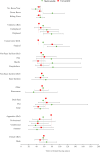Factors associated with time to return to horse racing following a clavicle fracture in jockeys competing in Great Britain: A review and analysis of medical records
- PMID: 39847551
- PMCID: PMC11756748
- DOI: 10.1371/journal.pone.0317724
Factors associated with time to return to horse racing following a clavicle fracture in jockeys competing in Great Britain: A review and analysis of medical records
Abstract
Purpose: Competitive horse racing is the second largest sport in Great Britain by spectator attendance, employability, and revenue. It is a lucrative yet hazardous sport, with high injury rates, particularly from falls. Clavicular fractures are one of the most common injuries reported, yet their management, especially regarding return to racing, is under-researched. The purpose of this study was to explore the factors associated with the time to return to competition following a clavicular fracture in jockeys competing in Great Britain.
Materials and methods: This review of medical records utilised data from the British Horseracing Authority spanning 2011-2018, inclusive. Data included the jockey's age, sex, type of licence, race discipline, location of incident, and fracture management. Descriptive statistics and univariable and multivariable generalised linear models were constructed to analyse the impact of these factors on the time to return to racing.
Results: Out of 212 records of clavicular fractures, 169 were analysed. The majority (82.8%) of fractures were managed conservatively, with the remainder requiring surgery. The median time to return to racing was 40 days, with an interquartile range of 34 days. Following a clavicular fracture, the results from the univariable and multivariable models indicated that the management approach, whether the fracture is displaced, and the type of race in which the injury occurred have the greatest influence on extending the time to return to racing. In contrast, professional, conditional and amateur licence types, as well as experiencing the injury at a racecourse, were associated with reduced time to return to racing, which may indicate greater risk-taking behaviour.
Conclusion: This study offers unique insights into key medical and contextual factors that influence the time to return to racing among jockeys in Great Britain, contributing to tailoring medical management and return to racing protocols to support jockeys' health and career longevity. Clinicians working within horse racing can use the findings of this study to provide return to racing guidance to trainers, riders and other medical professionals based on the key contextual information reported in this study.
Copyright: © 2025 Newton et al. This is an open access article distributed under the terms of the Creative Commons Attribution License, which permits unrestricted use, distribution, and reproduction in any medium, provided the original author and source are credited.
Conflict of interest statement
The authors have declared that no competing interest exist.
Figures
Similar articles
-
Epidemiology of race day injury in young professional jockeys in Great Britain from 2007 to 2018: a retrospective cohort study.BMJ Open. 2021 Aug 11;11(8):e044075. doi: 10.1136/bmjopen-2020-044075. BMJ Open. 2021. PMID: 34380713 Free PMC article.
-
Injuries outside of horseracing: is it time to focus on injury prevention of jockeys outside of races?Phys Sportsmed. 2021 Feb;49(1):45-50. doi: 10.1080/00913847.2020.1760693. Epub 2020 Apr 28. Phys Sportsmed. 2021. PMID: 32326866
-
A 9-Year Epidemiologic Study (2007-2015) on Race-Day Jockey Fall and Injury Incidence in Amateur Irish Horse Racing.J Athl Train. 2018 Oct;53(10):950-955. doi: 10.4085/1062-6050-339-17. Epub 2018 Oct 30. J Athl Train. 2018. PMID: 30376371 Free PMC article.
-
Injuries in professional horse racing in Great Britain and the Republic of Ireland during 1992-2000.Br J Sports Med. 2002 Dec;36(6):403-9. doi: 10.1136/bjsm.36.6.403. Br J Sports Med. 2002. PMID: 12453834 Free PMC article. Review.
-
Medicine in the Sport of Horse Racing.Curr Sports Med Rep. 2020 Sep;19(9):373-379. doi: 10.1249/JSR.0000000000000750. Curr Sports Med Rep. 2020. PMID: 32925377 Review.
References
-
- House of Commons Library, The future of horseracing [Internet]. England, United Kingdom: UK Parliament; c2023. [cited 2024 Nov 22]. Available from: https://commonslibrary.parliament.uk/research-briefings/cdp-2023-0200/#:....
-
- Frontier Economics [Internet]. England, United Kingdom: Department for Culture, Media and Sport; c2016. [cited 2024 Nov 22]. Available from: https://assets.publishing.service.gov.uk/media/5a80e15d40f0b62305b8dab0/...
MeSH terms
LinkOut - more resources
Full Text Sources
Medical


